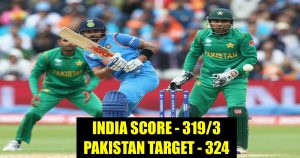
CT 2017: Here’s Why Pakistan Has To Hit 324 Runs To Win Against India’s 319
It was a good day so far. India has successfully started at the Champions Trophy with a bang on innings, the batsman did their best with every player fetching at least 50 runs for the team’s total. All together managed, to sum up, the total to 319 runs within 48 overs losing 3 wickets. This is so far the best performance despite the continuous interruptions in the match.
Coming to the statistics, Rohit Sharma top-scored for India with a steady 91 off 119 balls while Shikhar Dhawan, Virat Kohli, and Yuvraj Singh scored quick-fire fifties. Now, Pakistan needs to bat out of their skins as their target has been revised to 324. In spite of both the teams scheduled to bat for 48 overs, Pakistan’s target will be 324, five more than India’s actual total of 319 within the same number of overs.
Such a situation occurred because, a delay was observed during the match resulting in the reduction of overs, as per Duckworth-Lewis Stern system. The team chasing won’t have any such disadvantage because the team that batted first would have paced their innings in the expectation of playing, say, 50 overs but would have taken more risks to score faster had they known their innings was to be shortened all at once.
Meanwhile, the team batting second know from the start of their innings that they have a reduced number of overs and can pace their entire innings accordingly. Hence, the target is revised at the end of the first innings, the number of wickets lost by the team batting first will have an impact on the number of runs added to their total.
Earlier, a similar thing happened during the match between New Zealand and Australia a couple of days back where not even a single run was added to the Kiwi total because they lost all their wickets in their innings.
As of today, there were two rain breaks in the Indian innings that saw nearly swept 50 minutes in vain. It all started in the tenth over of the game when rain halted play for 50 minutes and on the next occasion, the match was stopped for 40 minutes in the middle of the 34th over. Due to this, few overs were lost and the match was reduced by 2 overs.
ICC rules state:
“If there were interruption(s) during Team 1’s innings, or Team 1’s innings was cut short, so the numbers of overs in the two innings are reduced (but still the same as each other), then (in the Professional Edition) D/L will adjust Team 2’s target score as described above. The adjustment to Team 2’s target after interruptions in Team 1’s innings is often an increase, implying that Team 2 has more resource available than Team 1 had.
“Although both teams have 10 wickets and the same (reduced) number of overs available, an increase is fair as, for some of their innings, Team 1 thought they would have more overs available than they actually ended up having. If Team 1 had known that their innings was going to be shorter, they would have batted less conservatively, and scored more runs at the expense of more wickets.
“They saved some wicket resource to use up in the overs that ended up being canceled, which Team 2 doesn’t need to do, therefore Team 2 has more resource to use in the same number of overs. Therefore, increasing Team 2’s target score compensates Team 1 for the denial of some of the overs they thought they would get to bat.”